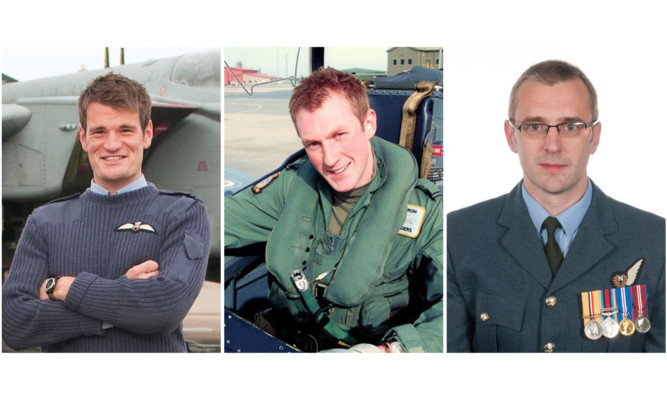No fatal accident inquiry will be held into a mid-air crash between two RAF Tornados which claimed three lives, the Crown Office has announced.
Flight Lieutenant Hywel Poole, 28, Flight Lieutenant Adam Sanders, 27, and Squadron Leader Samuel Bailey, 36, died in the collision over the Moray Firth on July 3 2012, while a fourth crewman was badly injured.
The Crown Office said a fatal accident inquiry (FAI) “could not better and would only repeat” the investigation already carried out by the Military Aviation Authority.
The Military Aviation Authority (MAA) service inquiry report, published on June30 last year, found there were 17 contributory factors to the accident,including the lack of a collision warning system (CWS) on both aircraft.
The inquiry said the cause of the accident was “a lack of recognition of converging flight paths” which saw the two jets in the same airspace at the same time.
It also noted the failures to have a working secondary surveillance radar on the day of the collision and exposed the fact that one of the two aircraft did not have a working radar homing and warning receiver that day.
The Crown Office’s Scottish Fatalities Investigation Unit began an investigation into the deaths following the tragedy but has decided that no further inquiry is necessary.
David Green, head of the Scottish Fatalities Investigation Unit, said: “Crown Counsel carefully weighed up the full circumstances of the case, and concluded that a fatal accident inquiry could not better and would only repeat the highly-detailed investigation into the tragedy already conducted by the Military Aviation Authority.
“The service inquiry report which they produced also contains conclusions and recommendations which are more wide-ranging than could be expected to be achieved in a fatal accident inquiry.
“The RAF and MOD have accepted the recommendations of the service inquiry report, and the nearest relatives of those who tragically died in this accident have been advised of Crown Counsel’s decision.”
The report also said one of the crew had been diagnosed with a “phobic anxiety disorder” related to flying which affected him at medium level. It said he had sought help for the condition.
One of the other contributory factors contained in the report’s summary of findings was the lack of a “formalised and effective care plan” for him.
The Crown Office said that all of the service inquiry’s recommendations have been accepted by the Ministry of Defence and are in the process of being implemented, including installation of collision warning systems.
The purpose of an FAI is to establish the cause of death and ensure that lessons are learned for the future.
Crown Counsel concluded that an FAI would only duplicate the months of “thorough work” undertaken by the Military Air Accident Investigation Branch and the Military Aviation Authority in preparing the service inquiry
